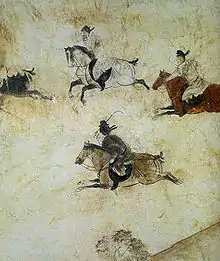Mausolée de Qianling
Le mausolée de Qianling (en chinois 乾陵, en chinois simplifié 乾陵, en pinyin Qián líng) est un vaste ensemble funéraire construit pour l'empereur Tang Gaozong. Il abrite également la dépouille de son épouse, l'impératrice Wu Zetian. Il est situé dans le comté de Qian, dans la province chinoise du Shaanxi, à environ 85 km au nord-ouest de Xi'an[2], ville autrefois capitale et alors appelée Chang'an.



Description
Construites en 684 (avec des constructions supplémentaires apportées jusqu'en 706), les tombes du mausolée abritent les restes de plusieurs membres de la famille royale Li, dont celles de Li Xian (zh) et de Li Xianhui. Le mausolée est renommé pour ses statues de pierre de la dynastie Tang situées au-dessus du sol et pour ses peintures murales placées sur les parois souterraines des tombes. Sous le tumulus principal, il y a, en plus des tombes de Gaozong et Wu Zetian, 17 plus petites tombes, appelées peizang mu[3]. Actuellement, seules cinq de ces tombes satellites ont été fouillées par les archéologues ; trois appartiennent à des membres de la famille royale, un à un chancelier de Chine et la dernière à un général de la garde[4]34° 34′ 28″ N, 108° 12′ 51″ E .
Références
- (en) Cet article est partiellement ou en totalité issu de l’article de Wikipédia en anglais intitulé « Qianling Mausoleum » (voir la liste des auteurs).
- Eckfeld (2005), 23.
- Valder (2002), 80.
- Eckfeld (2005), 26.34° 34' 23.37" N 108° 13' 6.94
- Eckfeld (2005), 26–27.
Bibliographie
- Dillon, Michael. (1998). China: A Historical and Cultural Dictionary. Surrey: Curzon Press. (ISBN 0-7007-0439-6).
- Eckfeld, Tonia. (2005). Imperial Tombs in Tang China, 618-907: The Politics of Paradise. New York: Routledge: (ISBN 0-415-30220-X).
- Fong, Mary H. "Tang Tomb Murals Reviewed in the Light of Tang Texts on Painting," Artibus Asiae (Volume 45, Number 1, 1984): 35–72.
- Fong, Mary H. "Antecedents of Sui-Tang Burial Practices in Shaanxi," Artibus Asiae (Volume 51, Number 3/4, 1991): 147–198.
- Fu, Xinian. (2002). "The Sui, Tang, and Five Dynasties," in Chinese Architecture, ed. Nancy Steinhardt, 91–135. New Haven: Yale University Press. (ISBN 0-300-09559-7).
- Guo, Qinghua. "Tomb Architecture of Dynastic China: Old and New Questions," Architectural History (Volume 47, 2004): 1–24.
- Howard, Angela Falco. (2006). Chinese Sculpture. New Haven: Yale University and Foreign Languages Press. (ISBN 0-300-10065-5).
- Jay, Jennifer W. "Imagining Matriarchy: "Kingdoms of Women" in Tang China," Journal of the American Oriental Society (Volume 116, Number 2, 1996): 220–229.
- Paludan, Ann. (1998). Chronicle of the Chinese Emperors: the Reign-by-Reign Record of the Rulers of Imperial China. London: Thames & Hudson Ltd. (ISBN 0-500-05090-2).
- Turner, Jane. (1996). The Dictionary of Art. New York: The Grove Press. (ISBN 1-884446-00-0)
- Steinhardt, Nancy Shatzman. (1990). Chinese Imperial City Planning. Honolulu: University of Hawaii Press. (ISBN 0-8248-2196-3).
- Steinhardt, Nancy Shatzman. (1997). Liao Architecture. Honolulu: University of Hawaii Press. (ISBN 0-8248-1719-2).
- Steinhardt, Nancy Shatzman. "The Tang Architectural Icon and the Politics of Chinese Architectural History," The Art Bulletin (Volume 86, Number 2, 2004): 228–254
- Valder, Peter. (2002). Gardens in China. Portland: The Timber Press, Inc. (ISBN 0-88192-555-1).
- (zh) 王晓莉, « 永泰公主墓壁画题材及艺术特色 », 文博, no 5, (présentation en ligne, lire en ligne)
Voir aussi
Liens externes
- (zh + en + ja) Site officiel
- Portail de la Chine
- Portail de l’histoire de l’art
- Portail du monde chinois